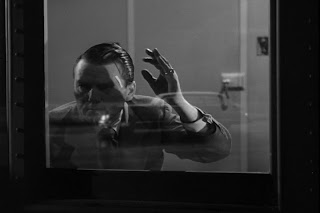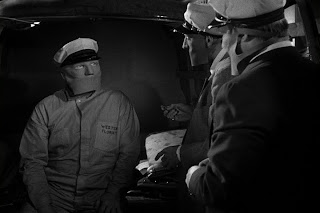 Released: August 4, 1950
Released: August 4, 1950Director: Gordon Douglas; Screenplay: Harry Brown based on the novel of the same name by Horace McCoy; Cinematography: J. Peverell Marley; Music: Carmen Dragon; Producer: William Cagney; Studio: Republic Pictures/Warner Brothers
Cast: James Cagney (Ralph Cotter), Barbara Payton (Holiday Carleton), Helena Carter (Margaret Dobson), Ward Bond (Charles Weber), Luther Adler (Keith “Cherokee” Mandon), Barton MacLane (Lt. John Reece), Steve Brodie (Joe “Jinx” Raynor), Rhys Williams (Vic Mason), Herbert Heyes (Ezra Dobson), John Litel (Police Chief Tolgate), William Frawley (Byers)
- “And now… would one fugitive from justice care to make another fugitive from justice… a sandwich?”
Find any review of this 1950 James Cagney film and I bet that you cannot make it out of the first paragraph before it's compared to the previous year’s White Heat. The similarities are quite obvious – Cagney playing a sociopathic, ambitious criminal that aspires to rise to the top of the underworld, plus similar criminal scheming and plotting. In fact, many reviews that I have seen in the past look up on Kiss Tomorrow Goodbye as basically being White Heat Part II, seeing very little distinction between the two. The two movies are no doubt similar, but it’s unfair to simply lump them together. They are both strong enough to stand on their own. It is not a stretch, though, to look toward Kiss Tomorrow Goodbye as the younger brother of White Heat. It is not quite to the level of that iconic film, lacking some key ingredients that elevate White Heat to even greater heights. Kiss Tomorrow Goodbye lacks the two dynamic female leads that Virginia Mayo and Margaret Wycherly provide as counterpoints to the fierce Cody Jarrett. The cinematography of Sid Hickox trumps anything done here by Peverell Marley. And comparing the directorial skills of Gordon Douglas and Raoul Walsh is a no-contest.
But, I’ll go ahead and let everyone in on a little secret… I think I like James Cagney’s performance here as Ralph Cotter even more than Cody Jarrett. And that alone is reason enough for the high placement in this countdown.
The interesting thing is that apparently Cagney was very reticent to even do this movie, not wanting to do yet another gangster film so soon after White Heat. But the production company that he had formed with his brother William was in financial difficulty at the end of the 1940s and needed to produce a profitable film in order to pay off debts. So instead of searching to find more versatile roles, Cagney reluctantly accepted the fact that him starring in a gangster picture was likely to make money – White Heat had proven that to still be true. When his brother William acquired the rights to Horace McCoy’s novel, James made the correct decision in choosing to star in it. The movie actually was a solid success, earning much needed profits for Cagney Productions.

Cagney plays Ralph Cotter, a vicious career criminal who has escaped from a prison work camp. His partner-in-crime is killed in the prison break, leaving Cotter to escape with his dead partner’s sister Holiday (Barbara Payton) and Jinx Raynor (Steve Brodie). Cotter works his way close to the innocent Holiday by holding over her head the fact that she is now a fugitive for having assisted in the escape. In the meantime, Cotter and Jinx team up in robberies and extortions that bring them to the attention of corrupt local police. When the cops begin shaking them down, Cotter responds with blackmail of his own. Eventually, Ralph concocts a scheme for one big final score, in which he, Jinx and the two corrupt police officers will steal money from the local mob. Adding another layer of complication to everything that Ralph is doing is the fact that he has met the beautiful heiress Margaret Dobson (Helena Carter), whose father Ezra Dobson (Herbert Heyes) is the richest and most powerful man in town. Ultimately, it is this relationship that contributes to Ralph’s complete fall.
I’ve said before in reviews of other Cagney films, but it is worth noting again: even though he is often accused of playing the same role again and again, each character is slightly nuanced from the others. In this case, Ralph Cotter may seem remarkably similar to Cody Jarrett, but in fact he’s even more coldblooded. With Cody, there are some obvious mental issues involved. Ralph Cotter, on the other hand, is in complete control psychologically and is fully aware of what he is doing. He knows how cruel he can be, chooses to use this callousness to his advantage, and does it all with a chuckle. He is what he is and enjoys it. It really is a marvelous performance, among the best that I have ever seen from Cagney, which is really saying something.
The script is surprisingly witty, with biting dialog and one-liners being rattled off by everyone in the film, with Cagney in particularly showing the wiseguy flair that he is famous for. As great a pulp writer as Horace McCoy is, though, the general story is weaker in some spots than others. When the story stays focused on Cotter and his criminal activities – the heists, the scheming, the dealing with dirty cops – it is as strong as the best crime films of the era. When it begins dealing with Ralph’s sudden relationship with Margaret, it really slows things down and feels disjointed. Fortunately, the majority of the focus remains on Ralph’s underworld maneuverings, taking the audience on a ride through a world where everybody is dirty or crooked to some degree. This might be the most underrated Cagney film that I have yet come across. If it doesn’t quite stack up against his truly best films, that is only because those others (Angels With Dirty Faces, White Heat, The Public Enemy) are masterpieces. This one is not quite a masterpiece, but its strong points almost get it there.


































